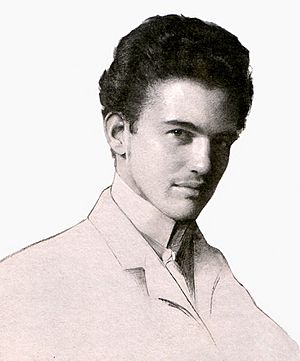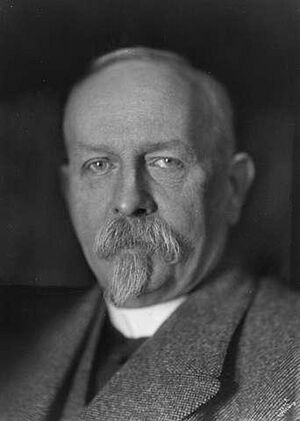Victor Goldschmidt facts for kids
Quick facts for kids
Victor Moritz Goldschmidt
|
|
|---|---|

Young Victor Goldschmidt
|
|
| Born | 27 January 1888 Zürich, Switzerland
|
| Died | 20 March 1947 (aged 59) Oslo, Norway
|
| Alma mater | University of Oslo |
| Known for | Geochemistry Goldschmidt tolerance factor Lanthanide contraction |
| Parent(s) |
|
| Awards | Foreign Member of the Royal Society Elliott Cresson Medal (1903) Wollaston Medal (1944) |
| Scientific career | |
| Fields | Geochemistry |
| Institutions | University of Oslo University of Göttingen Macaulay Institute for Soil Research Rothamsted Research |
| Thesis | Die Kontaktmetamorphose im Kristianiagebiet and Geologisch-petrographische Studien im Hochgebirge des südlichen Norwegens (1911) |
| Doctoral advisor | Waldemar C. Brøgger |
| Doctoral students | Brian Harold Mason Katharina Boll-Dornberger William Houlder Zachariasen |
| Influenced | Alfred Edward Ringwood |
Victor Moritz Goldschmidt (born January 27, 1888, in Zürich – died March 20, 1947, in Oslo) was a very important Norwegian mineralogist. Many people consider him to be one of the founders of modern geochemistry. Geochemistry is the study of the chemistry of the Earth. He also helped create the Goldschmidt Classification of elements, which helps us understand how elements are found in different parts of the Earth.
Contents
Early Life and Education
Victor Goldschmidt was born in Zürich, Switzerland, in 1888. His father, Heinrich Jacob Goldschmidt, was a chemist who studied how chemicals behave physically. His mother, Amelie Koehne, was the daughter of a lumber merchant. Victor's family had a long history of being well-educated.
His family moved several times because of his father's work. They lived in Amsterdam and Heidelberg before settling in Kristiania (now Oslo), Norway, in 1901. His father became a professor at the university there. In 1905, Victor's family became Norwegian citizens.
In 1906, Victor started studying at the University of Kristiana (now the University of Oslo). He studied many subjects, including chemistry, geology, and physics. He was very bright and received a scholarship for his advanced studies when he was just 21.
He worked on his main project with a famous geologist named Waldemar Christofer Brøgger. Victor earned his doctorate degree at 23 years old in 1911. His work was about how rocks change when they are heated by molten rock. For this important work, he received an award in 1912. Soon after, he became an Associate Professor of Mineralogy and Petrography at the university.
Career and Challenges
In 1914, Victor Goldschmidt was offered a professorship in Stockholm. To keep him in Norway, the University of Kristiania convinced the government to create a special institute and professorship just for him.
Later, in 1929, Goldschmidt became a professor in Göttingen, Germany. However, when the Nazis came to power, he became unhappy with how people who were not considered "Aryan" (like himself, as he was Jewish) were treated. Even though the university treated him well, he decided to leave in 1935 and returned to Oslo.
On April 9, 1940, Germany invaded Norway. In October 1942, Victor Goldschmidt was arrested by the German forces. This was part of the terrible treatment of Jewish people during World War II. He was taken to a concentration camp and became very sick. After a hospital stay, he was released but then arrested again.
However, just as he was about to be sent away to a very dangerous place, he was freed. Some of his colleagues convinced the police that his scientific knowledge was vital for the country. Victor then managed to escape to Sweden.
In March 1943, a British intelligence group flew him to England. He shared information about technical developments in Norway. He worked at the Macaulay Institute for Soil Research in Scotland. He also gave talks about rare elements found in coal ash.
Victor Goldschmidt later moved to Rothamsted Experimental Station, where he was well-liked. He was even nicknamed ‘Goldie’. He wanted to return to Oslo and did so in June 1946. Sadly, he passed away soon after, at the age of 59.
Scientific Discoveries
For his main university project, Victor Goldschmidt studied an area in Norway called the Oslo graben. This is a valley formed when a block of land sinks down between two cracks in the Earth's crust. In ancient times, hot molten rock pushed into older rocks in this area, heating them up. This heating caused the surrounding rocks to change, a process called contact metamorphism. This created a type of rock known as hornfels.
Goldschmidt carefully studied these hornfels rocks. He discovered that only certain groups of minerals would appear together in them. For example, some minerals could be found together, but others never were.
From his findings, Goldschmidt developed a "mineralogical phase rule." This rule helps explain how minerals form under different conditions like temperature and pressure. It basically says that the number of different minerals you find in a rock is usually not more than the number of basic chemical ingredients that make up the rock.
In the 1920s and 1930s, Goldschmidt and his team used a method called X-ray scattering. This method helps scientists see the tiny structures of crystals. By using this, they studied many common minerals. They then created a set of rules that explain how different chemical elements are grouped together in the Earth. Goldschmidt published all this important work in a series of books.
Awards and Honors
- In 1929, Victor Goldschmidt was made a Knight of the Order of St. Olav, a high honor in Norway.
- While in England, he was chosen as a Foreign Member of the Royal Society, a very respected scientific group.
- He also received an honorary degree from the University of Aberdeen.
- He was given the Wollaston Medal, which is the highest award from the Geological Society of London.
- A mountain ridge in Norway, Goldschmidtfjella, is named after him.
- A mineral called goldschmidtite (KNbO3) was named in his honor.
- The Geochemical Society gives out an award every year called the V. M. Goldschmidt Award to honor his contributions to geochemistry.
See also
 In Spanish: Victor Moritz Goldschmidt para niños
In Spanish: Victor Moritz Goldschmidt para niños
- Goldschmidt classification
- Goldschmidt Tolerance Factor
- Lanthanide contraction



